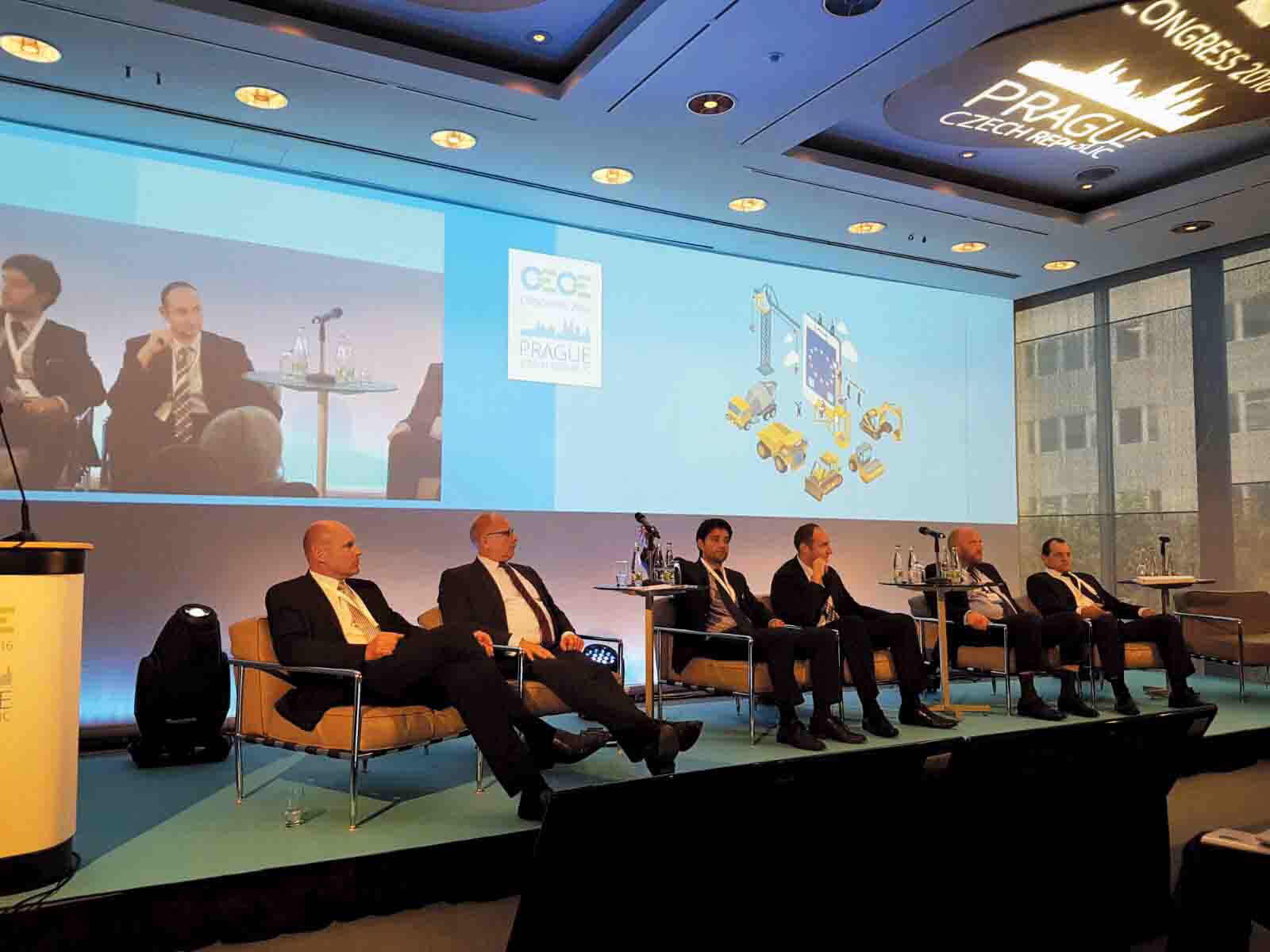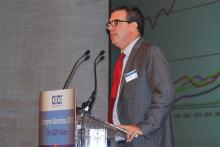The digital worksite topped the agenda at this year’s CECE congress. David Arminas reports from the Czech capital Prague*
Europe’s equipment manufacturers and their clients are truly in an age of transformation driven by an increasing move towards the digital worksite.
Because this transformation is so deep, there looms big challenges for the entire sector and its supply chain, noted Bernd Holz, president of the CECE – Committee for European Construction Equipment, Europe’s umbrella organisation for

(From the left) Tomas Kuta and Frank Schauff- wrestling with the Russian bear
The digital worksite topped the agenda at this year’s CECE congress. David Arminas reports from the Czech capital Prague*
Europe’s equipment manufacturers and their clients are truly in an age of transformation driven by an increasing move towards the digital worksite.
Because this transformation is so deep, there looms big challenges for the entire sector and its supply chain, noted Bernd Holz, president of the CECE –2440 Committee for European Construction Equipment, Europe’s umbrella organisation for national equipment groups.
During his opening presentation, Holz set the scene for the more than 200 delegates from original equipment manufacturers (OEMs), government agency officials and contractors. The theme for the three-day event was “Industry Transformation: driven by success”.
The past decade, he said, has seen great strides by manufacturers in creating lean production methods and becoming more customer focused to improve services for their clients. But now, managing the worksite digitally is more and more the key to success for both client and manufacturer, said Holz, who, since 2007, has been managing director of Swiss paving equipment manufacturer6791 Ammann.
A third of the Czech Republic’s economic output is based around manufacturing, said Zbynek Pokorny, director of the Czech government’s Department of Investments and Industrial Zones. The automotive industry accounts for the lion’s share, headed by vehicle maker Skoda.
But too often what passes for manufacturing in the country is simply the assembly of knock-down kits, he said. The republic, which is headed towards a €40 billion surplus for fiscal 2016, is keen to attract manufacturing research and development as well as design work for a more balanced manufacturing sector.
Pokorny urged equipment manufacturers to consider the country’s skilled workforce and also its lower wages compared with many parts of Europe. “The Czech republic is a safe haven for investment.”
Martin Krejci, director of investment at CzechInvest, part of the Department of Investments, urged contractors to take a serious look at bidding for highways work for the country’s “still not complete” road network.
8279 Uber and Apple are in the limelight for their attempts to develop self-driving vehicles. They throw a lot more R&D money at the problem than the construction sector has available to do so.
Nonetheless, the construction sector is quietly getting on with developing much more useable examples, according to Tomas Kuta, senior vice president of global sales for Volvo Construction Equipment. It is construction equipment OEMs and their suppliers who are really pushing the envelope of innovation for autonomous vehicles, he told delegates. “Autonomous vehicles with be the main driver for change,” he said.
Kuta later told World Highways that discussions with middle-to-large users of construction equipment, especially in the quarry sector, show that their main concern is now machine operator efficiency. The human element is where they see issues of efficiency that have to be controlled, he explained.
Issues include insufficient skills of drivers or machine operators, a shortage of suitable trained personnel, safety concerns, wages and more. These are the variables that often are not controllable and autonomous vehicle development could help in this area.
In his presentation, Ladislav Rulf, manager of consulting firm4137 KPMG’s Prague office, said the recent KPMG 2016 Construction Outlook confirmed the extent to which the sector is turning its attention away from only mechanical machine development and towards the digital worksite.
Industrie 4.0 (see box) has risen to be among the important issues for the sector within only three or four years, noted Rulf. A recent KPMG survey of equipment users indicated that 42% of respondents were using drones. It is not surprising that 65% of respondents said they are remotely monitoring their construction sites. In addition, a third said they are already using some kind of robotics for site work.
Around 70% are using embedded sensors to know what their machinery is doing, where they are operating and how they are performing.
With reference to research and development by equipment makers, Kuta responded to Rulf by suggesting that many manufacturers have spent up to 80% of their R&D budget on meeting engine emissions standards. But that sort of spend on engine development may be behind us now that emissions standards are getting about as good as they will get for some years and as customers seek more connectivity of their worksites.
Even so, innovation is about more than mechanical and digital development, warned Martin Knoetgen, president for Europe, Middle East and Africa operations at695 Doosan 1130 Bobcat. “It’s also about what we do as a business, our internal organisational structures and how we manage customer relations,” he said.
There are internal corporate challenges that must be faced by companies entering any foreign market and setting up shop, explained Hakan Ilhan, director of marketing and dealer development at269 LiuGong 3420 Dressta. Local employees will come with their own particular ways of communicating.
His experience has taught him that, for example, almost never will a Chinese manager openly disagree with his superior. He said that he has openly encouraged it but that is not the way of the Chinese and so this has to be factored into internal communications to enable the right messages to be passed along. The result is that both foreign company and its local employees change to a degree as they find their own way to accommodate each other’s cultural attributes.
Doing business in Russia continues to be a challenge, but perhaps not necessarily as a result of western sanctions because of that country’s takeover of the Crimea, reported Frank Schauff, chief executive of the Association of European Businesses in Russia. The association represents more than 500 European companies, not just construction, that are operating in Russia. These are mostly larger corporations investing in Russia which has close to half its foreign trade with the European Union. Over 50% of direct foreign investment into Russia comes from European sources.
Construction equipment manufacturers which have opened production facilities in Russia in the past few years include359 Volvo CE, 2300 Komatsu, 257 John Deere, 233 Hitachi, 718 Liebherr and 178 Caterpillar. Since 2015, larger foreign construction equipment OEMS have invested €1.6 billion into Russia and employ around 4,500 people.
In 2008, Russia’s economy growth rate was 6-8% annually but by 2009 it was -8%. It has recovered somewhat but still not reaching pre-2008 levels. The economic downturn is not necessarily due to western sanctions. Sanctions have focused on selling to the military sector and the offshore energy projects which is a small market for construction equipment makers. But sanctions on the financial sector has made borrowing capital in Russia much more expensive. And don’t forget, he said, offshore investments were few if any because of the global slump in oil prices.
Even so, the construction equipment market has shrunk by around 70% since 2013, he said.
Europe’s equipment manufacturers and their clients are truly in an age of transformation driven by an increasing move towards the digital worksite.
Because this transformation is so deep, there looms big challenges for the entire sector and its supply chain, noted Bernd Holz, president of the CECE –
During his opening presentation, Holz set the scene for the more than 200 delegates from original equipment manufacturers (OEMs), government agency officials and contractors. The theme for the three-day event was “Industry Transformation: driven by success”.
The past decade, he said, has seen great strides by manufacturers in creating lean production methods and becoming more customer focused to improve services for their clients. But now, managing the worksite digitally is more and more the key to success for both client and manufacturer, said Holz, who, since 2007, has been managing director of Swiss paving equipment manufacturer
A third of the Czech Republic’s economic output is based around manufacturing, said Zbynek Pokorny, director of the Czech government’s Department of Investments and Industrial Zones. The automotive industry accounts for the lion’s share, headed by vehicle maker Skoda.
But too often what passes for manufacturing in the country is simply the assembly of knock-down kits, he said. The republic, which is headed towards a €40 billion surplus for fiscal 2016, is keen to attract manufacturing research and development as well as design work for a more balanced manufacturing sector.
Pokorny urged equipment manufacturers to consider the country’s skilled workforce and also its lower wages compared with many parts of Europe. “The Czech republic is a safe haven for investment.”
Martin Krejci, director of investment at CzechInvest, part of the Department of Investments, urged contractors to take a serious look at bidding for highways work for the country’s “still not complete” road network.
Automotive vs Construction
Automotive manufacturers, their supply chains and other groups such asNonetheless, the construction sector is quietly getting on with developing much more useable examples, according to Tomas Kuta, senior vice president of global sales for Volvo Construction Equipment. It is construction equipment OEMs and their suppliers who are really pushing the envelope of innovation for autonomous vehicles, he told delegates. “Autonomous vehicles with be the main driver for change,” he said.
Kuta later told World Highways that discussions with middle-to-large users of construction equipment, especially in the quarry sector, show that their main concern is now machine operator efficiency. The human element is where they see issues of efficiency that have to be controlled, he explained.
Issues include insufficient skills of drivers or machine operators, a shortage of suitable trained personnel, safety concerns, wages and more. These are the variables that often are not controllable and autonomous vehicle development could help in this area.
In his presentation, Ladislav Rulf, manager of consulting firm
Industrie 4.0 (see box) has risen to be among the important issues for the sector within only three or four years, noted Rulf. A recent KPMG survey of equipment users indicated that 42% of respondents were using drones. It is not surprising that 65% of respondents said they are remotely monitoring their construction sites. In addition, a third said they are already using some kind of robotics for site work.
Around 70% are using embedded sensors to know what their machinery is doing, where they are operating and how they are performing.
With reference to research and development by equipment makers, Kuta responded to Rulf by suggesting that many manufacturers have spent up to 80% of their R&D budget on meeting engine emissions standards. But that sort of spend on engine development may be behind us now that emissions standards are getting about as good as they will get for some years and as customers seek more connectivity of their worksites.
Even so, innovation is about more than mechanical and digital development, warned Martin Knoetgen, president for Europe, Middle East and Africa operations at
There are internal corporate challenges that must be faced by companies entering any foreign market and setting up shop, explained Hakan Ilhan, director of marketing and dealer development at
His experience has taught him that, for example, almost never will a Chinese manager openly disagree with his superior. He said that he has openly encouraged it but that is not the way of the Chinese and so this has to be factored into internal communications to enable the right messages to be passed along. The result is that both foreign company and its local employees change to a degree as they find their own way to accommodate each other’s cultural attributes.
A Russian revolution
On Russia, Kuta - who worked in Moscow in the early 2000s - acknowledged that many multinationals in all sectors have been exiting Russia because of compliance and business ethics. A lot of business traditionally is done on “close governmental alliances”. However, there appears a kind of revolution over the issues. Many of the medium to large contractors and manufacturers who are toughing it out in Russia are successfully applying their global standards to how they do business. It’s a slow change, but a change nonetheless.Doing business in Russia continues to be a challenge, but perhaps not necessarily as a result of western sanctions because of that country’s takeover of the Crimea, reported Frank Schauff, chief executive of the Association of European Businesses in Russia. The association represents more than 500 European companies, not just construction, that are operating in Russia. These are mostly larger corporations investing in Russia which has close to half its foreign trade with the European Union. Over 50% of direct foreign investment into Russia comes from European sources.
Construction equipment manufacturers which have opened production facilities in Russia in the past few years include
In 2008, Russia’s economy growth rate was 6-8% annually but by 2009 it was -8%. It has recovered somewhat but still not reaching pre-2008 levels. The economic downturn is not necessarily due to western sanctions. Sanctions have focused on selling to the military sector and the offshore energy projects which is a small market for construction equipment makers. But sanctions on the financial sector has made borrowing capital in Russia much more expensive. And don’t forget, he said, offshore investments were few if any because of the global slump in oil prices.
Even so, the construction equipment market has shrunk by around 70% since 2013, he said.








